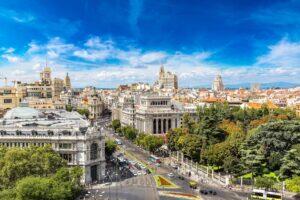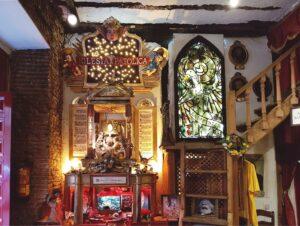Fodor's Expert Review Palacio Real
The Palacio Real was built over Madrid's first defensive fortress, established by Berbers in the 9th century. It overwhelms with its sheer immensity against the city's silhouetted background. The palace was commissioned in the early 18th century by the first of Spain's Bourbon rulers, Felipe V. Outside, classical French architecture adorns the Patio de Armas: Felipe was obviously inspired by his childhood days at Versailles with his grandfather Louis XIV. Look for the stone statues of Inca prince Atahualpa and Aztec king Montezuma, perhaps the only tributes in Spain to these pre-Columbian American rulers. Notice how the steep bluff drops west to the Manzanares River—on a clear day, this vantage point commands a view of the mountain passes leading into Madrid from Old Castile. It's easy to see why Madrid's Berber rulers picked this spot for a fortress.
Inside, 2,800 rooms compete with one another for over-the-top opulence. A two-hour guided tour in English winds a mile-long path... READ MORE
The Palacio Real was built over Madrid's first defensive fortress, established by Berbers in the 9th century. It overwhelms with its sheer immensity against the city's silhouetted background. The palace was commissioned in the early 18th century by the first of Spain's Bourbon rulers, Felipe V. Outside, classical French architecture adorns the Patio de Armas: Felipe was obviously inspired by his childhood days at Versailles with his grandfather Louis XIV. Look for the stone statues of Inca prince Atahualpa and Aztec king Montezuma, perhaps the only tributes in Spain to these pre-Columbian American rulers. Notice how the steep bluff drops west to the Manzanares River—on a clear day, this vantage point commands a view of the mountain passes leading into Madrid from Old Castile. It's easy to see why Madrid's Berber rulers picked this spot for a fortress.
Inside, 2,800 rooms compete with one another for over-the-top opulence. A two-hour guided tour in English winds a mile-long path through the palace. Highlights include the Salón de Gasparini, King Carlos III's private apartments, with swirling inlaid floors and curlicued stucco wall and ceiling decoration, all glistening in the light of a two-ton crystal chandelier; the Salón del Trono, a grand throne room with the royal seats of King Felipe VI and Queen Letizia; and the banquet hall, the palace's largest room, which seats up to 140 people for state dinners. Despite being the official seat of the throne, no monarch has lived here since 1931, when Alfonso XIII was deposed after a Republican electoral victory. The current king and queen live in the far simpler Palacio de la Zarzuela on the outskirts of Madrid.
Also inside the palace are the Museo de Música (Music Museum), where five-stringed instruments by Antonio Stradivari form the world's largest such collection; the Painting Gallery, which displays works by Spanish, Flemish, and Italian artists from the 15th century on; the Armería Real (Royal Armory), with historic suits of armor and frightening medieval torture implements; the Real Oficina de Farmacia (Royal Pharmacy), with vials and flasks used to mix the king's medicines; and the Real Cocina, Europe's best-preserved royal kitchens, opened to the public for the first time in 2017 and whose framed handwritten menus, antediluvian wood-burning ovens, enormous copper cauldrons, wooden iceboxes, and nearly 3,000 antique kitchen utensils make it a must-stop for foodies. On Wednesday the Changing of the Guard takes place (every 30 minutes from 11–2) at the Puerta del Príncipe, across Plaza de Oriente, with a more solemn and lavish ceremony (with up to 100 guards and horses) the first Wednesday of each month at noon.
READ LESS








